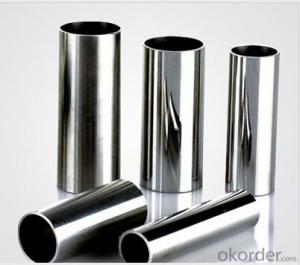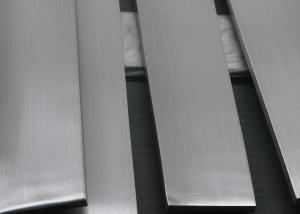Looking for agent !!! stainless steel pipe / tube 201 304 316 430
- Loading Port:
- Tianjin
- Payment Terms:
- TT OR LC
- Min Order Qty:
- 25 m.t.
- Supply Capability:
- 1000 m.t./month
OKorder Service Pledge
Quality Product, Order Online Tracking, Timely Delivery
OKorder Financial Service
Credit Rating, Credit Services, Credit Purchasing
You Might Also Like
Quick Details
| Standard: | JIS,AISI,ASTM,GB,ASTM A554 | Place of Origin: | China (Mainland) | Brand Name: | OKORDER |
| Model Number: | SUS 304 201 316 430 | Type: | Welded | Steel Grade: | 200,300,400 series |
| Application: | Decorative or industrial,stainless steel for handrail, fence, gate,furniture | Certification: | ISO | Welding Line Type: | ERW |
| Thickness: | 0.24mm-3.0mm | Outer Diameter: | 8-219mm | Diameter: | 6.35mm-219mm |
| product: | steel | Series: | 200,300,400 |
Packaging & Delivery
| Packaging Detail: | Each piece in polybag and several pieces per bundle,or according to customer's request. |
| Delivery Detail: | 25-30 days after deposit |
Specifications
stainless steel pipe
1. With 8--10.5% Ni and 18--20% Cr
2.Thickness :0.24--3mm
3.Customized specification
- Q: Can stainless steel pipes be used for oil and gas transportation?
- Indeed, the utilization of stainless steel pipes for the transportation of oil and gas is plausible. Due to its exceptional resistance to corrosion and durability, stainless steel has become a favored material choice within the oil and gas industry for pipe construction. These pipes possess the capability to endure harsh circumstances, including high pressure, extreme temperatures, and corrosive surroundings, rendering them appropriate for the conveyance of oil and gas. Furthermore, the purity of the transported fluids is maintained by stainless steel pipes, as they exhibit no reactivity or contamination towards the substances being conveyed. As a result, stainless steel pipes are an unquestionably dependable and efficient option for oil and gas transportation.
- Q: Can stainless steel pipes be hydrotested?
- Yes, stainless steel pipes can be hydrotested. Hydrostatic testing is a common method used to check the integrity and strength of pipes, regardless of the material they are made from. Stainless steel pipes can withstand hydrostatic pressure well and are frequently subjected to hydrotesting to ensure they meet safety and quality standards.
- Q: Can stainless steel pipes be used in nuclear power plants?
- Yes, stainless steel pipes can be used in nuclear power plants. Stainless steel is a commonly used material in the construction of nuclear power plants due to its high strength, corrosion resistance, and ability to withstand high temperatures. Stainless steel pipes are particularly suitable for carrying coolant, gases, and other fluids within the power plant. These pipes are able to handle the demanding conditions and requirements of a nuclear power plant, including the high pressure and high temperatures that are present in certain parts of the plant. Additionally, stainless steel is resistant to the corrosive effects of radiation, making it a reliable choice for use in nuclear power plants.
- Q: Can stainless steel pipes be used for oil and gas applications?
- Indeed, oil and gas applications can benefit from the utilization of stainless steel pipes. Due to its remarkable resistance to corrosion and capability to endure extreme temperatures and pressures, stainless steel emerges as an optimal substance for the conveyance and preservation of oil and gas. Moreover, these pipes exhibit exceptional mechanical qualities, encompassing elevated tensile strength and fortitude, guaranteeing their longevity and dependability within rigorous oil and gas surroundings. Consequently, stainless steel pipes find widespread employment across diverse sectors of the oil and gas industry, encompassing drilling, production, refining, and transportation of oil and gas commodities.
- Q: Are stainless steel pipes suitable for hydraulic applications?
- Yes, stainless steel pipes are suitable for hydraulic applications. They offer excellent corrosion resistance and durability, making them ideal for use in hydraulic systems where fluid flow and pressure are involved. Additionally, stainless steel pipes can handle high temperatures and are resistant to cracking, making them a reliable choice for hydraulic applications.
- Q: Can stainless steel pipes be welded to other materials?
- Yes, stainless steel pipes can be welded to other materials. However, it is important to consider the compatibility of the materials being welded together and ensure proper welding techniques are used to achieve a strong and reliable joint.
- Q: Why can stainless steel pipes be welded by argon arc welding?
- Argon protection can isolate the harmful effects of oxygen, nitrogen and hydrogen on the arc and molten pool in the air, and reduce the burning loss of alloy elements, so as to obtain compact, no spatter and high quality welded joints;
- Q: Can magnets attract stainless steel tubes?
- There are two kinds of stainless steel, one is made of nickel as the main component of stainless steel, one is chromium as the main component of stainless steel. The magnet can absorb chromium containing stainless steel and can not suck nickel containing stainless steel.
- Q: How do you calculate the wall thickness of a stainless steel pipe?
- The wall thickness of a stainless steel pipe can be calculated by subtracting the inner diameter from the outer diameter, and then dividing the result by 2.
- Q: Can stainless steel pipes handle high-velocity fluid flow?
- High-velocity fluid flow can indeed be handled by stainless steel pipes. Renowned for their remarkable strength, durability, and corrosion resistance, stainless steel pipes are well-suited for managing high-velocity fluid flow. They possess the ability to endure the pressure and turbulence created by swiftly moving fluids. Moreover, the smooth inner surfaces of stainless steel pipes reduce friction and aid in sustaining the velocity of the fluid flow. As a consequence, stainless steel pipes find widespread application in industries like oil and gas, chemical processing, and power generation, where encounters with high-velocity fluid flow are frequent.
Send your message to us
Looking for agent !!! stainless steel pipe / tube 201 304 316 430
- Loading Port:
- Tianjin
- Payment Terms:
- TT OR LC
- Min Order Qty:
- 25 m.t.
- Supply Capability:
- 1000 m.t./month
OKorder Service Pledge
Quality Product, Order Online Tracking, Timely Delivery
OKorder Financial Service
Credit Rating, Credit Services, Credit Purchasing
Similar products
Hot products
Hot Searches
Related keywords























